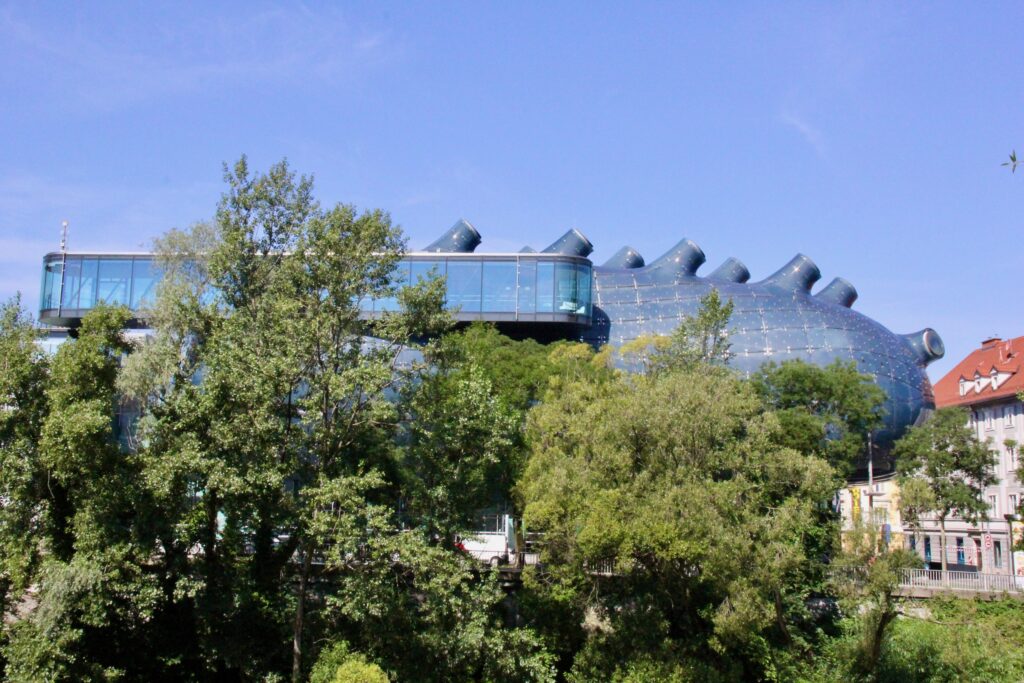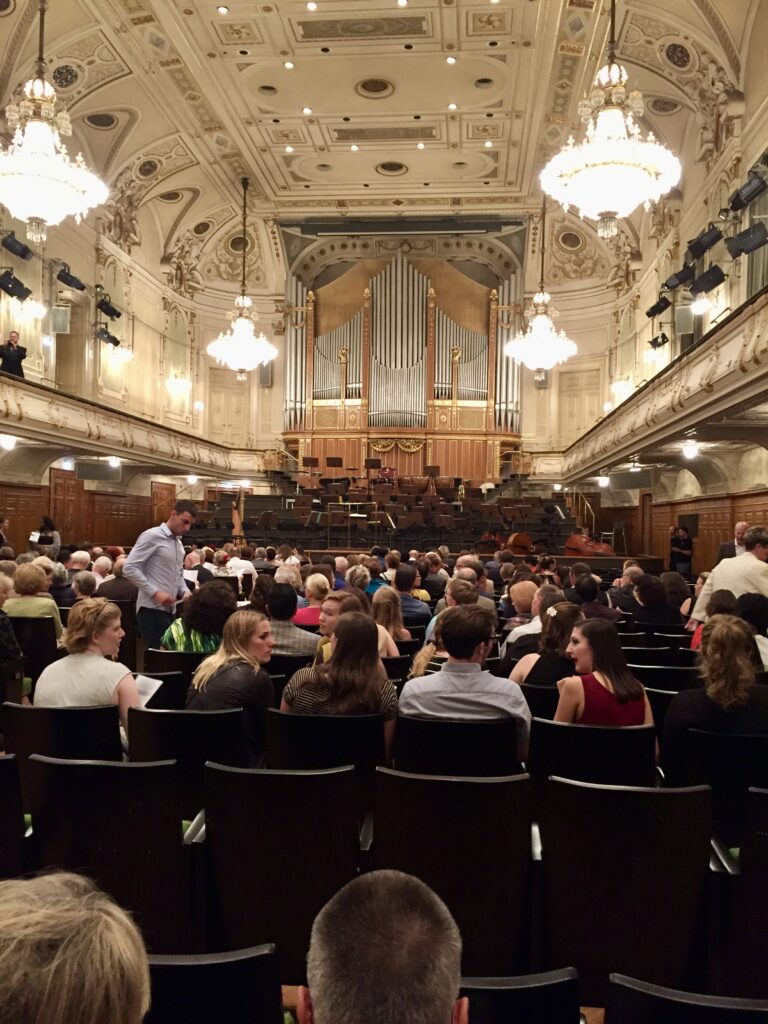Graz is Austria’s second largest city and is 197 km south of Vienna. Graz lies on the River Mur and is famous for being the birthplace of Hollywood star Arnold Schwarzenegger. The bus ride from Vienna to Graz was little more than 2 hours long. We visited the city mainly to meet up with my daughter who was part of a 2-month summer music program.
Graz Old town – The UNESCO-designated Old Town can be easily explored on foot and is filled with historical buildings. We started off with a visit to Hauptplatz, the Main Square, on the left bank of the River Mur. The main square has the City Hall (Rathaus), that was built in 1893.



The main square also has a fine statue of Archduke Johann (1782-1859), who did much to bring industry to the region and improve communications and trade. There is also the 17th-century Haus am Luegg, with its attractive arcaded and stucco-decorated facade. The wide empty area in front of the town hall offers room for various events.



To the west of the Main Square is the Gothic Franciscan Church (Franziskanerkirche), notable for its west tower from 1643 and its Late Gothic nave with a ribbed vaulted ceiling. The high tower, one of the more prominent Graz landmarks, is unusual for a Franciscan establishment. It owes its existence to the church’s strategic location next to the city walls, and was built as a fortified tower by the city authorities in the 17th century

Graz Art Museum – Was built as part of the European City of Culture in 2003 and has since become an architectural landmark in Graz. The building is an example of blob architecture(amoeba-like building), and has a skin made of iridescent blue acrylic panels that also double as photovoltaic panels. Owing to its shape contrasting with its surroundings, it is known in local vernacular as the “Friendly Alien”. The museum exhibits contemporary art of the mid-20th century from around the world. The exhibits are changed regularly.


Schlossberg and the Clock Tower – The Schlossberg (Castle Mountain) is a tree-covered hill and the site of a fortress in the centre of the city. The hill, at 473 m (1,552 ft) above sea level, is now a public park and offers an extensive view of the city. You can either take a 3-min funicular railway to the top or alternatively, it can be reached by a pleasant 20-minute walk (260 steps).


At the top is the city’s best-known landmark, the 28-meter-tall Clock Tower (Uhrturm). Built in 1561, it’s all that’s left of the massive fortifications that once stood here and which were dismantled after the Treaty of Vienna in 1809.



Several other attractions that are here include a beautiful garden, the 94-meter-deep Turkish Well (Türkenbrunnen), and the 35-meter-tall Belfry (Glockenturm) from 1588 with its eight-ton bell affectionately known as Liesl.


Murinsel – Murinsel, or Mur Island, is a man-made island built in the middle of River Mur. It was built when Graz became the 2003 European Capital of Culture. It looks more like a ship than an island. The 47-meter-long island is entirely made of steel and takes on the shape of an upside-down seashell. It’s tethered to the banks of the river by two footbridges. The Murinsel has an amphitheater situated in the middle. This space is used for concerts, performances, and other events. There is also a café where you can sit and relax while taking in the breathtaking views.


St. Catherine church and Mausoleum of Ferdinand II – In 1614 Ferdinand commissioned his Italian court painter and architect Giovanni Pietro de Pomis to erect a mausoleum and an adjacent St. Catherine’s Church next to today’s Cathedral. It was to become one of the most important buildings of the early 17th century in Austria. The oval dome above the tomb chapel was the first of its kind built outside Italy. The façade of St. Catherine’s demonstrates the taste of time at the threshold of Renaissance and Baroque.
In 1619 Ferdinand was elected emperor and left Graz for Vienna. Construction work at the Mausoleum came to a standstill. De Pomis died at the age of 63 without ever seeing his Mausoleum completed. So in 1637 Ferdinand was laid to rest in a half-finished, “draughty” tomb. Only his grandson, Emperor Leopold I, commissioned a young Graz artist, to finish the interior. The young artist later on became the famous Austrian Baroque architect Johann Bernhard Fischer von Erlach.


Graz Cathedral – Also called St. Giles’ Cathedral, the Cathedral is a mix of Gothic and Baroque style. It was built at the time Graz was the seat of Emperor Frederick III, in the 15th century. Graz Cathedral is dedicated to Saint Giles. It is the seat of the bishop of the Steiermark diocese. The exterior of the cathedral looks very sober today. In the Gothic period, however, the facades were covered with paintings. The interior of the church is richly decorated and full of beautiful paintings.



AIMS Orchestra – We attended an orchestra concert in which my daughter was a part of. AIMS (American Institute of Musical Studies) is a leading summer music program in Europe. The program is designed to prepare one for a career as a professional musician. In the six weeks of intense training, many participants feel they learn more in a summer at AIMS than in a year or more at school. And it all takes place in Graz, Austria.




Miscellaneous Pictures – Graz had some great restaurants and cafes.


Street art in Graz – There are murals and street art all over the town.


Other sites in Graz that we were not able to visit :
- The Styrian Armoury – Known to be the worlds’ biggest historical armory, its permanent collections include 13,400 small arms and accessories, of which 4,259 are pistols. The artillery collection contains volley guns, mortars, cannons, falconets, and their accessories, and there are more than 2,000 edged weapons – swords, broadswords, and sabers.
- The Landhaus and Courtyard – In the heart of Graz’s Old Town stands the majestic Landhaus, home to the Styrian provincial government. Built in Renaissance style in 1565, it’s a beautiful building. After passing through the main façade, dominated by rounded windows and a loggia, you’ll end up in the superb arcaded courtyard with its three-storied pergolas on two sides. There’s also a beautiful Renaissance fountain.
- Graz Burg – Another government building, this old palace is famous for its 15th-century double spiral staircases (the Staircase of Reconciliation), which meet on each floor, creating a bizarre optical illusion. During World War II, the castle sustained significant damage and underwent reconstruction from 1947 onwards. Between 1950 and 1952, new structures were added, forming what is now called the New Castle. Presently, alongside the provincial governor’s offices, the castle hosts several departments of the Styrian provincial government. While access to the castle is limited, visitors can explore its courtyards and the iconic double spiral staircase, appreciating its historical significance from the exterior.
- Mariatrost Basilica – The Baroque Mariatrost Basilica sits at the top of a hill, ascended by more than 200 steps that pilgrims climb, reading the messages as they go. The interior of this popular pilgrimage church is Baroque, although the Madonna on the high altar is late Gothic in origin. It has great views and a popular place to watch the sunset.
- Schloss Eggenberg – Atop a hill just three kilometers west of Graz’s city center stands the stunning 1635 Baroque palace. It features four large towers, fine state apartments, and rich Rococo fittings.